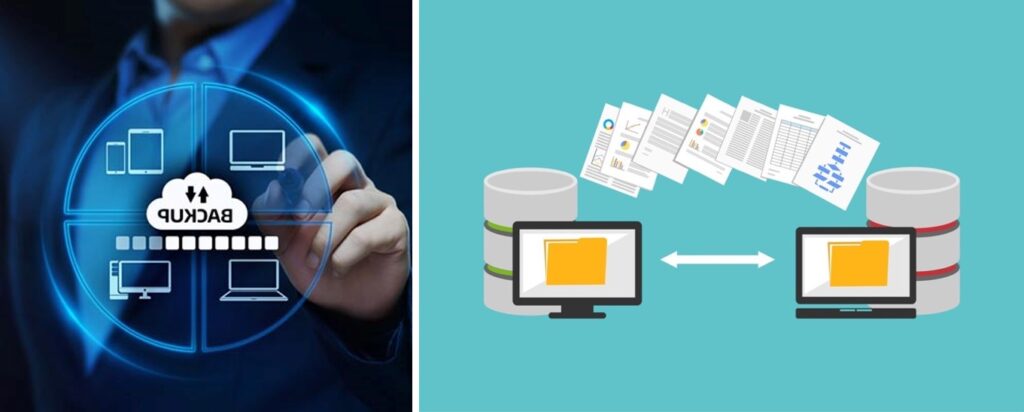Table of contents

Overview
A virtuous and robust data backup is vital for every company’s business continuity plan. During these unprecedented times, ransomware threatens business organisations regardless of their size, industry and power. Thus, the risk of data loss is high. Therefore, a robust and secure data backup ensures recovery of corrupted or lost data due to various causes such as:
- Injected malware corrupting your data.
- Employees or other insider threats deleting your digital assets.
It is imperative for companies to employ an efficient and cost-effective data backup procedure that ensures regular backups to one or more locations, at pre-determined frequencies, and at different capacities.

What Is a Data Backup?
Since data is the lifeblood of modern organizations, having data backup is critical for all businesses, large and small. Any loss of critical data can result in significant damages and disrupt regular business operations. In the case of unexpected malicious action, accident, or disaster, a virtuous ‘data backup’ ensures a smooth recovery to normal operations.
Essentially, backup data should consist of any data that you wish to preserve or is important in running your organisation smoothly. This includes:
- Documents
- Configuration files
- Operating Systems
- Machine Images
- Media Files
- Registry Files
Why is it important for an organizations to have a data backup strategy?
The following statistics shed light and highlight the potential impact of disasters on businesses that fail to have a secure data backup strategy as part of a complete disaster recovery plan. Accordingly, an average of 2,244 cyberattacks occur globally each day. These attacks target businesses with sensitive data.

Here are some alarming statistics:

- The average cost of downtime to a business is $5,600 per minute according to Gartner. Moreover, 6% of companies without a disaster recovery strategy in place survive.
- The most common causes of data loss are hardware/system failure (31%), human error (29%) and viruses, and malware of ransomware (29%).
- During 2017, WannaCry infected more than 300,000 computers worldwide, encrypting sensitive business data and disrupting productivity for an entire week causing a financial loss of, up to $4 billion according to one estimate.
Likewise, the following statistics highlight the importance of data protection. Nowadays, company data is its most valuable asset. Therefore, just as a business owner will purchase insurance to protect their physical business assets, a secure backup process acts as ‘insurance’ against data loss incidents.

How often should you perform a backup?

The first step in creating an effective backup plan is to prioritize how often data requires backing up. Organizations should prioritize backing up their most important files, performing back-ups more frequently. For instance, personal user files and non-essential data should be backed up less frequently.
What is the most effective backup strategy?
The 3-2-1 rule is the best practice for backing up data. It protects against accidents and malicious threats, such as ransomware and viruses, and ensures reliable data backup and restoration. The following strategy works accordingly:
- Three copies of data
- Two different storage types
- One copy off-site

Here are 10 key practices to ensure ‘secure data backup’
1. Include backup in your security strategy
Even though, having a ‘backup plan’ seems costly or overwhelming, the cost of not having a backup can be way more. Fundamentally, keeping in mind recovery from data loss will cost your business a fortune as the average cost of a ransomware attack on a business is $133,000, should encourage you to ensure your security policies include backup-related systems within their scope. Ideally, every type of security policy applies directly to data backups from access control to physical security to system monitoring and, especially, malware protection.
2. Backup systems must be included in your DR strategy
An incident response plan will outline how emergency data backups are compromised. Such as:
- ransomware outbreak,
- employee break-In
- environmental including a flood or hurricane
Nevertheless, not including data backup systems in your recovery plan can adversely affect good backups.
3. Ensure access to data backup is limited
Did you know? 60% of businesses that experience data loss shut down within six months. Hence, the backup process must only involve those who have clear business needs. Assign backup access rights for backup software as well as the actual backup files. Don’t overlook systems that are both on the local network and in the cloud that provide backup access.
4. Remote Backups or considering different backup locations
In terms of convenience and cost effectiveness, a remote backup solution is ideal for a business looking to save money and avoid purchasing backup equipment. Ensuring your remote data is secure by encrypting it before transferring it to the backup location is important or if you have sensitive data living in AWS, consider engaging with an AWS cloud company such as CSG Technologies to help ensure it remains available.
5. Physical access to data backups must be limited
In facilities regardless of how you choose to store backup access must be controlled adequately. Whether it is on backup servers, NAS, or even external drives or tapes handle your backup files as you would any other critical hardware. To validate whether you are doing so, use SOC audit reports, independent security assessment reports or your own audits
6. Protection of backup media devices
Today, the most common methods of data storage are:
- hard disk or solid-state drives
- portable drives
- tapes and related media
Accordingly, the most ideal for storing back up are a fireproof and media-rated safe. However, most people tend to use a fireproof safe which is a false sense of security because backup media such as tapes, optical disks and magnetic drives have a lower burning/melting point than paper.
7. Prioritising Data Encryption
When data is unencrypted, it is more of a liability than an asset. Since, data breaches can easily compromise unencrypted. It is essential to encrypt your data backup.
Encrypt your data backups before you need to access them after a breach. Whether using a cloud backup, remote backup, onsite backup, or physical backup, there are options to encrypt your data before a disaster occurs ensure your data backup strategy includes a review of security procedures and a plan for data encryption in transit and at rest.
Implementation and management of encryption in the right way serves as an excellent last layer of defence. Therefore, it is essential to backup data wherever possible be it laptop computers and other mobile devices. Moreover, encrypt backup files and media with strong passwords or use encryption technology to centrally manage. Especially, if they have been removed from premises.
8. Vendor Security Measures should be evaluated
It is extremely important to consult third-party stakeholders on how they are ensuring backups remain safe in their hands. Thus, their steps for protecting data center, cloud and courier service providers are known.
There is no guarantee for exposure of sensitive data when depending on contracts. Thus, the business umbrella vendor management initiative must contain reasonable and consistent security measures.
9. Network Security
Ransomware, DDOS attacks, Phishing Scams malware, and other cyberattacks have attacked tens of thousands of businesses and destroyed them in the blink of an eye.
- Ensure the store backups are on a separate file system or cloud storage service that’s located on a physically separated network.
- To minimize ransomware-related risks use unique login credentials outside of the enterprise directory service.
- Multifactor authentication is able to add an additional layer of security in your backup environment.
10. Create Secure backup with regular testing
‘Your backups are only as good as what’s on the backup media.’
Foremost, backups are server or application centric, which means there is unstructured data scattered about your network and in the cloud which is not getting backed up. So, make sure you’re backing up everything.
Second, if you’re not getting any errors on your backups, it is highly likely that your backups are not legitimate or that you’ve backed up the wrong data or no data at all. To avoid this from happening, test your backups occasionally.
Finally, investigate your data backup processes and systems to identity whether there are gaps or hire an unbiased third-party to find the holes.

Summary
The World Backup Day,March 31st, serves as a reminder on the importance of backing up to protect data.
Valuable data is impossible to recover or replace. Even though, there are solutions to recover data partially or completely, it highly depends on the situation. Therefore, an organizations top priority is to invest in backing up data. Proper backup data files are the most effective solution to prevent or at least mitigate data loss incidents.
Overall, it is an aspect of security that organizations should prioritize given the importance of data in their operations.



